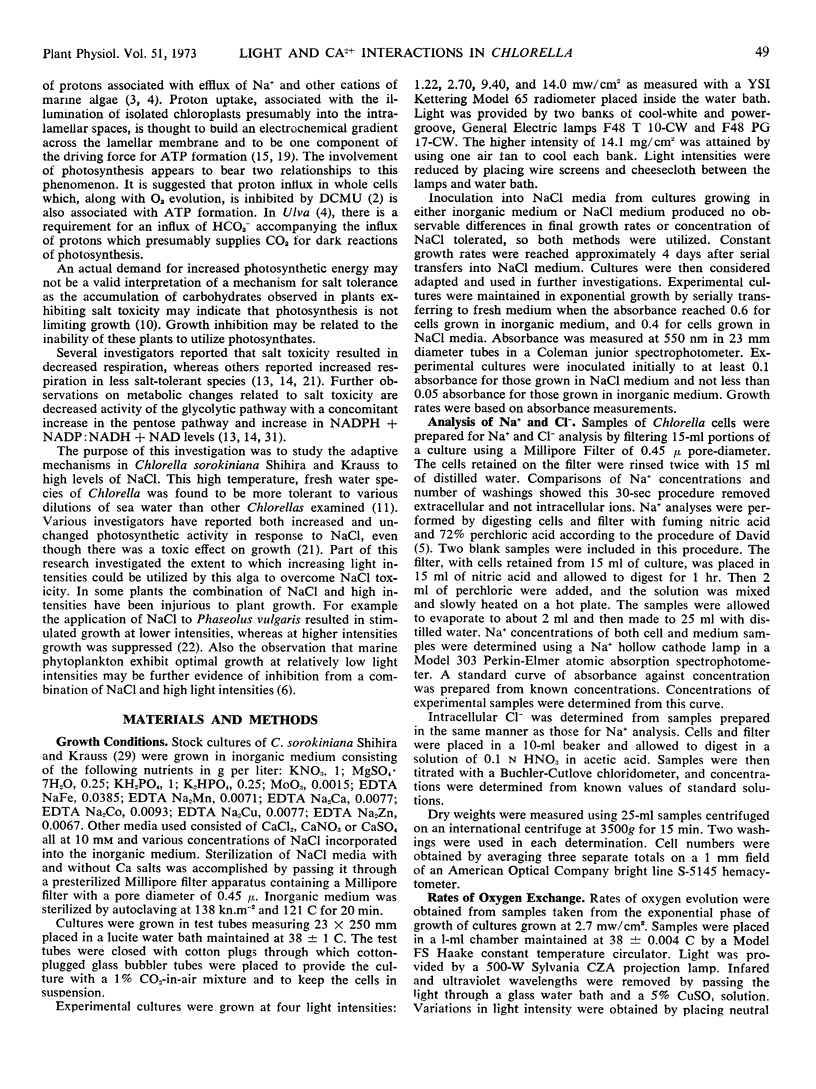Abstract
Analysis of NaCl toxicity in Chlorella sorokiniana showed decreased growth rates, increased dry weight per cell, increased intracellular Na+ and Cl−, more total chlorophyll per cell, a decreased chlorophyll a to chlorophyll b ratio, increased rates of O2 evolution, and decreased rates of CO2 fixation when the extracellular concentration of NaCl was increased from zero to 0.3 m. Cultures did not grow at concentrations greater than 0.3 m NaCl unless 10 mm calcium salts were present. Inclusion of that concentration of Ca2+ extended the tolerance to 0.5 m NaCl before growth stopped. Increasing the light intensity from 1.2 to 9.4 mw/cm2 increased growth rates for cultures in 0.10 to 0.45 m NaCl. At 14 mw/cm2 added Ca2+ reduced growth rates of cultures in 0.3 m NaCl compared to controls without added Ca2+. Maximal growth rates for cultures in NaCl media were achieved by addition of 10 mm CaSO4 and maintenance of the light intensity at 9.4 mw/cm2. The maximal growth rate of the organism was 9.6 doublings/day achieved at 2.7 mw/cm2 for control cultures. In 0.3 m NaCl the growth rate was 4.3 doublings/day at 2.7 mw/cm2 and 8.2 doublings/day at 9.4 mw/cm2 with 10 mm CaSO4 added.
Increasing light intensities from 2.7 to 9.4 to 14 mw/cm2 decreased intracellular Na+ in cells cultured in 0.3 m NaCl medium without added Ca2+ and increased Cl− uptake in cells cultured in 0.3 m NaCl medium with and without added Ca2+. For cells cultured in 0.3 m NaCl medium at 14 mw/cm2 intracellular Na+ was 0.68 meq/g dry weight with Ca2+ added and 0.81 meq/g dry weight without Ca2+ added. Addition of Ca2+ at 2.7 mw/cm2 reduced intracellular Na+ to similar values. It is postulated that energy requirements for active Na+ exclusion were reduced by addition of Ca2+ allowing more energy to be used for cell growth resulting in increased growth rates.
O2 evolution and CO2 fixation studies indicated that increased photosynthetic energy, probably actuated by a high proton gradient accompanying Cl− influx and uncoupled from CO2 fixation, was available for maintenance of cellular integrity and active control of intracellular ionic ratios. The O2 evolving capacity was destroyed at 12 and 29 mw/cm2 for cells cultured in 0.3 m NaCl medium respectively with and without the addition of Ca2+. Control cultures continued producing O2 at light intensities up to 115 mw/cm2.
Full text
PDF








Selected References
These references are in PubMed. This may not be the complete list of references from this article.
- Barber J. Measurement of the membrane potential and evidence for active transport of ions in Chlorella pyrenoidosa. Biochim Biophys Acta. 1968 Jun 11;150(4):618–625. doi: 10.1016/0005-2736(68)90051-5. [DOI] [PubMed] [Google Scholar]
- Ben-Amotz A., Ginzburg B. Z. Light-induced proton uptake in whole cells of Dunaliella parva. Biochim Biophys Acta. 1969 Jun 3;183(1):144–154. doi: 10.1016/0005-2736(69)90138-2. [DOI] [PubMed] [Google Scholar]
- Cummins J. T., Strand J. A., Vaughan B. E. The movement of H+ and other ions at the onser of photosynthesis in ulva. Biochim Biophys Acta. 1969 Mar 11;173(2):198–205. doi: 10.1016/0005-2736(69)90103-5. [DOI] [PubMed] [Google Scholar]
- EPPLEY R. W. Sodium exclusion and potassium retention by the red marine alga, Porphyra perforata. J Gen Physiol. 1958 May 20;41(5):901–911. doi: 10.1085/jgp.41.5.901. [DOI] [PMC free article] [PubMed] [Google Scholar]
- Findlay G. P., Hope A. B., Pitman M. G., Smith F. A., Walker N. A. Ionic fluxes in cells of Chara corallina. Biochim Biophys Acta. 1969;183(3):565–576. doi: 10.1016/0005-2736(69)90170-9. [DOI] [PubMed] [Google Scholar]
- Gauch H. G., Eaton F. M. EFFECT OF SALINE SUBSTRATE ON HOURLY LEVELS OF CARBOHYDRATES AND INORGANIC CONSTITUENTS OF BARLEY PLANTS. Plant Physiol. 1942 Jul;17(3):347–365. doi: 10.1104/pp.17.3.347. [DOI] [PMC free article] [PubMed] [Google Scholar]
- Gutknecht J. Ion distribution and transport in the red marine algae, gracilaria foliifera. Biol Bull. 1965 Dec;129(3):495–509. doi: 10.2307/1539728. [DOI] [PubMed] [Google Scholar]
- Hasson-Porath E., Poljakoff-Mayber A. Content of adenosine phosphate compounds in pea roots grown in saline media. Plant Physiol. 1971 Jan;47(1):109–113. doi: 10.1104/pp.47.1.109. [DOI] [PMC free article] [PubMed] [Google Scholar]
- Jagendorf A. T., Uribe E. ATP formation caused by acid-base transition of spinach chloroplasts. Proc Natl Acad Sci U S A. 1966 Jan;55(1):170–177. doi: 10.1073/pnas.55.1.170. [DOI] [PMC free article] [PubMed] [Google Scholar]
- Lahaye P. A., Epstein E. Salt toleration by plants: enhancement with calcium. Science. 1969 Oct 17;166(3903):395–396. doi: 10.1126/science.166.3903.395. [DOI] [PubMed] [Google Scholar]
- Lilley R. M., Hope A. B. Chloride transport and photosynthesis in cells of Griffithsia. Biochim Biophys Acta. 1971 Jan 12;226(1):161–171. doi: 10.1016/0005-2728(71)90188-5. [DOI] [PubMed] [Google Scholar]
- Mitchell P. Chemiosmotic coupling in oxidative and photosynthetic phosphorylation. Biol Rev Camb Philos Soc. 1966 Aug;41(3):445–502. doi: 10.1111/j.1469-185x.1966.tb01501.x. [DOI] [PubMed] [Google Scholar]
- Raven J. A. Ion transport in Hydrodictyon africanum. J Gen Physiol. 1967 Jul;50(6):1607–1625. doi: 10.1085/jgp.50.6.1607. [DOI] [PMC free article] [PubMed] [Google Scholar]
- Reger B. J., Krauss R. W. The photosynthetic response to a shift in the chlorophyll a to chlorophyll B ratio of chlorella. Plant Physiol. 1970 Oct;46(4):568–575. doi: 10.1104/pp.46.4.568. [DOI] [PMC free article] [PubMed] [Google Scholar]
- Shieh Y. J., Barber J. Intracellular sodium and potassium concentrations and net cation movements in Chlorella pyrenoidosa. Biochim Biophys Acta. 1971 Jun 1;233(3):594–603. doi: 10.1016/0005-2736(71)90158-1. [DOI] [PubMed] [Google Scholar]
- Weimberg R. Enzyme levels in pea seedlings grown on highly salinized media. Plant Physiol. 1970 Sep;46(3):466–470. doi: 10.1104/pp.46.3.466. [DOI] [PMC free article] [PubMed] [Google Scholar]


